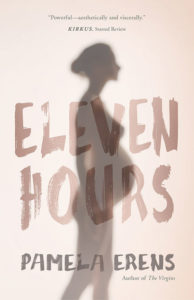 [Tin House; May 2016]
[Tin House; May 2016]
I only learned what an epidural was a few short months ago; I was standing behind the check-out counter during my bookstore shift, reading Meaghan O’Connell’s essay, “A Birth Story.” Panicking, I turned to my co-worker. Did you know that an epidural can paralyze you, I half-asked, half-stated. She shrugged, yes. A shrug?
We’re conditioned to treat the process of childbirth with a shrug, a “yes.” It seems like an easy acceptance of a physical pain unique to only a segment of the human population. We gloss over that and over the emotional tumult with the mantra, “yes, but isn’t a child worth it all.” We only discuss the emotional weight in whispers, citing postpartum depression as a condition, a melancholy that not all who go through a pregnancy experience. This idea that sadness associated with childbirth is an uncommon condition stunts our capacity to acknowledge that perhaps waves of solitude are normal within the unique action of birthing.
In her novel, Eleven Hours, Pamela Erens gracefully brings the isolating effects of childbirth to the forefront of the pregnancy narrative. Although the physical ordeal is present throughout (rendered in a way that provokes a shudder of imagined pain through your body, rather than queasiness), Erens maintains the focus on the emotional drain of the hospital and of imagining motherhood. The women in the novel, Lore and Franckline, allow themselves to become wrapped up in the self-imposed sequestration of their respective pregnancies. With Eleven Hours, Erens reminds us of the normalcy of choosing and indulging in solitude.
Both Lore and Franckline narrate Eleven Hours, their voices floating seamlessly from one to the other. The two women meet in the maternity ward of a hospital on Sixth Avenue — Lore is there to give birth, and Franckline is her maternity ward nurse (and pregnant, but not yet showing). Much to Franckline’s surprise — and piquing her interest — Lore shows up “all alone shortly before 9:00 AM, lugging her duffel bag, her tall body pitched to one side with the weight, no man with her, no mother, no friend (and yet a ring on the ring finger of her left hand: a silver band). No one at all, which is almost unheard of.”
It is this calculated, calm solitude — not the pregnancy — that draws Lore and Franckline together. Despite her stringent birth plan with an emphasis on giving birth very much on her own (no fetal monitor, no IV, no epidural) and her general stubbornness (it is almost impossible for Franckline to convince Lore to have her ring removed, even at the risk of needing to amputate the finger), Lore deems Franckline worthy of being her partner through the labor. Her desire for solitude, or at the very most, Franckline’s companionship, is so strong that at one point Lore lies to another nurse about a rape and an abortion in order to be left alone:
Good God, why had she said that? But the plump little woman’s friendliness had been so false, so deaf; she’d wanted to say something to puncture it. Well, that had certainly done it. Where is Franckline, Lore wonders? Why did I say such a thing?
This action, coming from Lore, who until then comes across as rather mild-mannered and kind (she is a public school speech therapist), emphasizes her need to avoid the narrative of pleasantry and joy imposed on pregnancy in preference of sitting with hurt and anxiety.
Throughout Lore’s eleven hours of labor, both women reveal their tumultuous familial and romantic histories. The two, both immigrants to the city — Lore from working-class, upstate New York, Franckline from Haiti — came with, like many, a desire to shed their past. Lore arrives in New York completely alone after years of caring for her ailing, now deceased, mother. Only a few short weeks after her move Lore meets Julia, a native New Yorker and artist, and assimilates into Julia’s foreign Upper West Side life. Julia immediately sets Lore up with her childhood friend (and on-again-off-again love interest) Asa, and the two get married — and so begins the love triangle in which Lore is entangled. Franckline, unlike Lore, does not arrive in New York completely alone. She comes to the city from Haiti with her husband after exile from her family due to an accidental pregnancy (and miscarriage) in her teens. Although they not once articulate these stories to each other, Erens’ breezy prose and the fluidity between Lore and Franckline’s narrative voices suggest that the women understand each other, or at least understand their respective needs for space and self-sufficiency.
To place Lore and Franckline’s stories within the framework of childbirth reminds us of the multitude of lives coinciding with the birth of one. Erens refocuses the pregnancy narrative, in all its gruesome pain, isolation, and complexity, from the child onto the woman. Eleven Hours is not a novel about mother creating life and mother uniting with child. It is, instead, about women realizing themselves as women — let me emphasize that I do not mean they find womanhood because they are pregnant, as that would conflate womanhood and motherhood. Rather, the novel explores the multitudinous nature of womanhood by using the characters’ pregnancies as a means of engaging with their lives and sufferings. In fact, at the end, Erens never gives us the expected satisfaction of Lore holding her child, instead including a detail from Lore’s birth plan, emphasizing her desire for the natural state of pain and loneliness:
IN THE EVENT THAT THE BABY DIES, I seek the following:
• To be able to see and hold the baby for as long as I wish
• Not to be given tranquilizers or drugs that blunt feeling
• To arrange the funeral myself
Julia Irion Martins is an editorial assistant at The Village Voice. Follow her on Twitter @juliairion.
This post may contain affiliate links.







